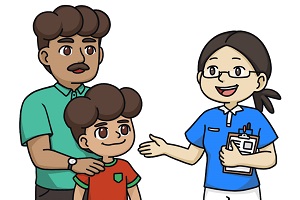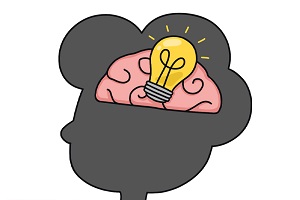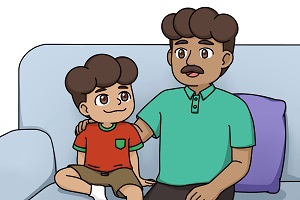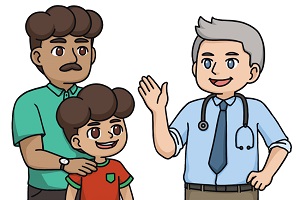Options for managing ADHD
Summary
- There are two ways to manage the symptoms of ADHD – either with or without medicine.
- Both non-medicine and medicine options can help children with ADHD.
- Your child’s doctor and other health professionals will help you find the best way to support your child. What works for your child might be different to what works for other children and their families.

Research has shown us that both treatments with and without using medicine can help children with ADHD.
Even if your child is taking medicine to help with their ADHD, it works best when used with other strategies that help your child with their learning, friendships and family relationships.
This is called multi-modal treatment.
There are lots of ways you can help your child with their attention, regulation and concentration skills at home. You can also work with your child’s teacher to support their learning, friendships, and overall well-being at school.
For more ideas on ways to help your child take a look at the webpages and online materials available at attention, regulation and concentration.
Medicine to support attention, regulation and concentration
Research shows that medicine is an effective way to reduce the symptoms of ADHD for children and young people.
Medicine can improve focus, control impulsive behaviour (doing things without thinking) and reduce hyperactivity. Children are then better able to learn, socialise and take part in family activities.
There are two types of medicines used to treat the symptoms of ADHD – stimulant and non-stimulant medicines.
They are generally safe and effective. However, like any medicine, they may cause side effects. A side effect is an unexpected or unwanted reaction.
Most side effects caused by medicine for ADHD are manageable and don’t last long.
It’s important for your child to regularly see their doctor. They will carefully monitor your child’s response to the medicine and their overall development and physical health.
They will make sure the medicine is working and watch to see if there are any side effects. This will include regular checks of your child’s weight, height and blood pressure.
Watch the video below to find out more about what's involved with starting medication for ADHD.
Resources
ADHD: supporting children and pre-teens | Raising Children Network
Information on specific medicines: Choice and Medicine │ WA Health
Australian evidence-based clinical practice guideline for ADHD – Consumer Companion Guide | AADPA
For more information about medicine for ADHD you can explore:
Summary
- Stimulant medicine is effective in improving focus, impulsive behaviour and hyperactivity.
- Stimulant medicines are considered safe for children. Any side effects of these medicines are usually only mild.

Stimulant medicine is the most effective treatment available for reducing the symptoms of ADHD.
It’s usually the first choice for medication treatment, unless there is a medical reason why it may not be suitable.
Stimulant medicines work for most children with ADHD.
How do stimulant medicines work?
Stimulant medicines work by increasing the availability of certain brain chemicals, particularly dopamine and noradrenaline.
These chemicals are important in communicating between brain cells. They help circuits that connect different areas of the brain.
These circuits include:
- attention
- organisation
- decision-making
- emotional responses
- responding to rewards.
They help to strengthen the useful signals and reduce the signals that aren’t necessary.
Different forms of stimulant medicine
Stimulants can come in different forms including immediate-release (short-acting) and slow-release.
Short-acting medicines take effect quickly but sometimes another dose is needed during the day.
Slow-release medicines work over a longer period of time.
The common stimulants are:
- Methylphenidate (immediate-release forms): Ritalin®, Artige®
- Methylphenidate (slow-release forms): Concerta®, Ritalin LA®, Methylphenidate XR ARX®
- Dexamfetamine (immediate-release)
- Lisdexamfetamine: Vyvanse® (slow-release)
Methylphenidate, Dexamfetamine and Lisdexamfetamine all work equally well, and have been found to have similar side effects. Some children find one works better than the others.
Stimulant medicines are the first choice for ADHD, as research shows that they are more effective for more children than non-stimulant medicines.
Your doctor will usually try stimulant medicines before deciding to use a non-stimulant medicine.
Short-acting stimulant medicines are taken 2 or 3 times a day (morning, midday and sometimes in the afternoon) and work for between 3 and 5 hours per dose.
Long-acting stimulant medicines are taken once a day (morning) and work for between 8 and 12 hours per dose.
Starting stimulant medicines
Your child’s doctor will recommend starting at a low dose and increasing gradually. This allows time to see if the medicine is helping your child.
The dose of medicine your child’s doctor prescribes may be different to that of other children and is not affected by their age or body weight.
Most children start on a short-acting stimulant medicine before changing to a long-acting medicine. Older children can be started on Lisdexamfetamine (Vyvanse®).
Side effects
Your child’s doctor will talk in detail with you and your child about any possible side effects. A side effect is an unexpected or unwanted reaction caused by a medicine.
Most side effects caused by medicine for ADHD are manageable and don’t last long.
Your doctor will help manage any side effects by changing the dose or timing of the medicine. Sometimes the medicine will need to be changed.
Common side effects include:
- headache*
- tummy upset*
- feeling nervous*
- difficulty falling asleep
- reduced appetite
- mild emotional changes
- increased hyperactivity or emotional change in the afternoon.
* These side effects are usually mild and may last for approximately 2 weeks after your child starts taking the medicine.
Rare side effects include:
- poor growth
- significant or major changes in mood
- tics (an involuntary, repetitive movement or sound)
- changes to blood pressure that are of concern.
It is important to always talk to your child’s doctor about any side effects.
Stimulant medicines don’t need a weaning off period like some other medicines and can be stopped at any time.
If your child is taking medicine and has severe mood swings or aggression, stop the medicine and talk to your child’s doctor.
Resources
ADHD: supporting children & pre-teens | Raising Children Network
Australian evidence-based clinical practice guideline for ADHD – Consumer Companion Guide | AADPA
Information on specific medicines: Choice and Medicine │ WA Health
Summary
- Your child might be prescribed non-stimulant medicine if stimulant medicine isn’t working well.
- These medicines take effect more gradually and last for longer. It can take up to 3 months before you can tell if they are making a difference for your child.
- Non-stimulant medicines are safe for children and usually cause only mild side effects.
Non-stimulant medicine is a second option if stimulant medicine is not working well, or if it’s not suitable for your child. These medicines have been shown to work for up to 6 out of 10 children.
Common non-stimulant medicines are:
- Atomoxetine
- Guanfacine: Intuniv®
Your doctor will usually start with a low dose to see how your child responds, before increasing the dose to a level that works well for your child.
How do non-stimulant medicines work?
Each non-stimulant medicine works in a different way. However, they all change the levels of brain chemicals used to strengthen the ‘useful’ signals between different areas of the brain.Atomoxetine and Guanfacine both work by targeting the brain chemical ‘noradrenaline’. This chemical is involved in attention, planning and impulse control.
- Atomoxetine acts on the way noradrenaline is transported in circuits within the brain.
- Guanfacine acts on specific receptors in the brain to make noradrenaline (and dopamine) more available and more active.
Non-stimulant medicines work differently to stimulants.
- They take effect more gradually and last longer.
- They help throughout the day and into the evening and the effects last for up to 24 hours.
- It can take about 3 months before you can see their full effect.
- Unlike stimulant medicines, stopping non-stimulant medicines suddenly can be harmful.
Non-stimulant medicines can be useful for children who:
- can’t take stimulant medicines due to their side effects
- have an existing condition like severe anxiety that might be worsened by taking stimulant medicine
- have tried stimulants and they have not helped.
Side effects
It is important to always talk to a doctor about any side effects you or your child notice.
Common side effects for Guanfacine include:
- difficulty falling asleep
- dry mouth
- feeling sleepy
- low blood pressure or dizziness
- low heart rate.
Common side effects for Atomoxetine include:
- reduced appetite
- tummy upset
- difficulty falling asleep
- constipation
- mood change.
Rare side effects
- rash
- thoughts of self-harm.
If your child is taking medicine and experiences a rash or thoughts of self-harm talk to your child’s doctor BEFORE stopping the medicine.
Stopping suddenly can be harmful.
Resources
ADHD: supporting children & pre-teens | Raising Children Network
Australian evidence-based clinical practice guideline for ADHD – Consumer Companion Guide | AADPA
Information on specific medicines: Choice and Medicine │ WA Health
Summary
- Some parents worry about their child starting medicine for ADHD.
- Your child may feel worried too.
- It’s important to remember that these medicines are safe and will usually help your child.
- Talk to your child about how medicines for ADHD might help them and make them feel.

What to say to your child
It’s important your child has some understanding of what ADHD is and how it affects the way their brain works. When you talk about your child’s ADHD, keep the conversation positive and remind them of their strengths.
Use the words that your child uses when they describe how their brain works. For example:
'You know how sometimes you tell me your brain doesn’t want to pay attention. That’s because it works a little differently to some other people’s brains. This is called ADHD'.
Use simple words to explain what the medicine does. For example, 'This medicine will help all the parts of your brain work together. It will help you concentrate and learn new things'.
Encourage your child to talk about how the medicine makes them feel. Explain that it’s normal to feel a little bit different when they first start taking the medicine.
You can also tell them that the medicine won’t work right away and that it might take a few weeks to see if it helps.
Taking medicine for ADHD
Medicine for ADHD works best when it is taken at the same time each day. Your child’s doctor will tell you when they need to have their medicine.
Use a daily reminder to help you remember to give your child their medicine. For older children, give them some responsibility for remembering to take their medicine.
When your child starts a new medicine, you may like to keep a medicine diary in the first few weeks. Write down any effects of the medicine (both good and bad). Don’t forget to ask your child how they feel.
Let your child’s teacher know when they start taking medicine. The teacher can then notice how your child is responding at school and if there are any side effects.
Sometimes children may refuse to take medicine. You can help your child by:
- being positive yourself
- allowing your child to take the medicine themselves with your supervision
- giving your child time to take the medicine
- never forcing your child to take the medicine.
Talking with your child’s doctor
Your child’s doctor will involve both you and your child in the discussion about starting medicine for ADHD. Your child will need to visit their doctor regularly to check how the medicine is helping them.
Encourage your child to talk to the doctor about the medicine and to ask any questions they have.
If your child is worried about swallowing tablets, talk to their doctor about how you can make this easier for them.
Always talk to your child’s doctor about any side effects you or your child have noticed.
Remember to always store medicines safely so young children can’t reach them.
Please watch the two videos below to learn more about medication for ADHD and family conversations about ADHD.
Resources
Complex ADHD Service booklet – Chapter 7 │ Child and Adolescent Health Service
How to talk to your child about their ADHD │ Australasian ADHD Professionals Association


